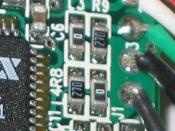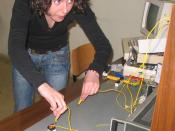Aim
Investigating the factors that affect resistance in a wire.
Theory
Ohm's law states the V=IR, with 'V' being voltage, 'I' being current and 'R' being resistance. Voltage is sometimes called potential difference (PD). It is measured in volts. Potential difference is caused by the unbalanced state of atoms. When an electron leaves the orbit of an atom it leaves a positive charge, this positive charge will attract any atoms that are negatively charged to make it a balanced atom. To have current flow, you must have a source of electrons. If they have a path to flow through, they will be attracted to the ions. Voltage is the difference in electrical potential between two points in a circuit. It's the push or pressure behind current flow through a circuit. Current is what flows on a wire or conductor like water flowing down a river. Current flows from points of high voltages to points of low voltage on the surface of a conductor.
Current is measured in amps or amperes. Resistance determines how much current will flow through a component. Resistors are used to control voltage and current levels. A very high resistance allows a small amount of current to flow. Resistance is measured in ohms ( ).
Hypothesis
I think that the longer the wire is, the higher the resistance. This is because the current will have to travel a longer distance against resistance. If there were a short wire, the current would need to travel a shorter distance against the resistance. I also predict that the thicker the wire the less the resistance. I believe this because if the cross sectional area was larger, the resistance would be a smaller fraction of the thickness. Please look at the diagram below.
Take the inner, dark blue circle...


